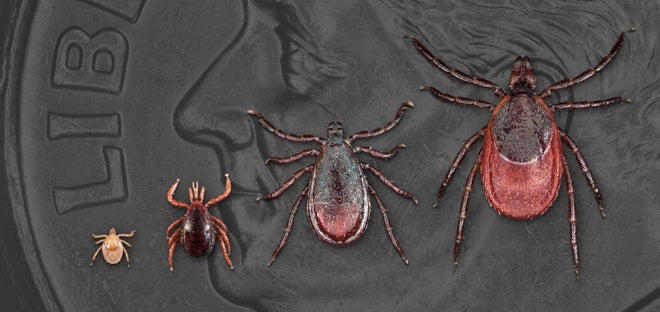
Peak tick season is approaching across the U.S and researchers are expecting this summer to be particularly brutal.
But, is it the worst ever?
University of Rhode Island entomologist Dr. Thomas “The TickGuy” Mathers told The Independent that it’s too early to call it but the numbers are looking worrying — he’s received more submissions of nymphal blacklegged ticks, which carry Lyme disease, to the university’s TickSpotters platform so far this month than the weekly average for the same period over the last decade.
“I don’t know the answer just yet, if it’s a trend going up – but I suspect it is, just based on the number of nymphal blacklegged ticks I’ve seen in the past couple of weeks,” he explained.
Mathers noted that federal data shows emergency room visits related to ticks are up this year, with visits nearly doubling from 70 in April, to 131 in May.
Other researchers who also count ticks are noticing a significant jump in specimens.
Dr. Saravanan Thangamani, a professor at New York’s SUNY Upstate Medical University who runs the Upstate Tick Testing Laboratory, has warned that more ticks are being sent to the lab than at the same time last year, marking a 217 percent increase.
“Based on the trend in tick submission I have observed thus far, I expect a tick season that is worse than the previous years,” he cautioned.
But, Rutgers University professor and entomologist Dina Fonseca is not ready to make that call quite yet. She’s a part of the submission project called New Jersey Ticks 4 Science!
She said people say it’s the worst year for ticks every year, noting there’s no standardized tick surveillance. They’re seeing more submissions, as well, but they don’t know if it’s just because more people are reporting them.
“Frankly, we don’t have enough data over time to be able to say, ‘Is it a worse year than normal or a better year than normal?’ We don’t know,” explained Fonseca.
What threats do US ticks pose?
Whatever the case may be, the heightened activity between June and July leaves Americans exposed to 90 species of ticks and the diseases they can carry. Although ticks are on both coasts, they’re largely found in the eastern U.S. Some, like brown dog ticks and blacklegged ticks, are located more widely.
Not being prepared for ticks while doing outside activities and camping could carry a death sentence — although that’s an extremely rare outcome.
People bitten by ticks may be exposed to Powassan virus, Babesiosis, Anaplasmosis, Tularemia, Lyme disease, and other pathogens that can cause human disease. People can be affected by multiple diseases at once.
The nymphal blacklegged ticks are the ones Fonseca says people really need to worry about, as they can be infected with four different disease agents. That includes Lyme disease, which may lead to facial paralysis and irregular heartbeat if untreated.
Although larger than larval ticks, nymphal ticks are only the size of a poppy seed. They may be hard to spot – even for people who are aware of their region’s ticks and where they live.
“Look at the bowtie of Lincoln on a penny; that’s the size of a nymphal blacklegged tick, Fonseca said.

Exposure and prevention
While it’s easy to miss ticks, it can take about two days for any transmission to occur after a bite. People who find ticks on their skin should remove them with tweezers as soon as possible. Those who develop a rash or fever after removal should consult a doctor.
As far as prevention goes, knowledge is power. Reducing exposure is the best way to avoid negative health outcomes. Mather advises that people follow what he calls the “three Ts.” Wear tight clothing, tuck in shirts and pants legs, and wear clothes treated with 0.5 percent permethrin repellent.
“If you don’t apply repellent, they can be ruthless,” Fonseca said, recalling a time when she picked 30-to-40 ticks out of her hair. Mathers remembers a trip to Fire Island that resulted in the exposure to “literally hundreds” of fast-crawling ticks.
Unfortunately, with a changing climate comes additional chances to pick up the blood-sucking hitchhikers. With a warmer atmosphere comes a wetter world, and parasites thrive in those conditions, and ticks have been observed moving north. Southern aridity is their enemy.
“One of the easiest ways to kill a tick is to dry the heck out of them,” said Fonseca.




